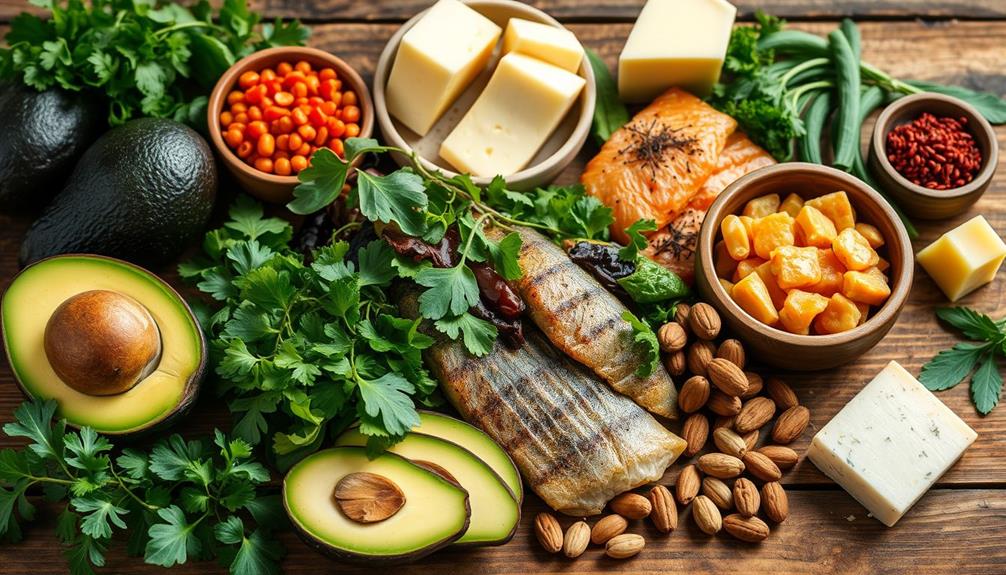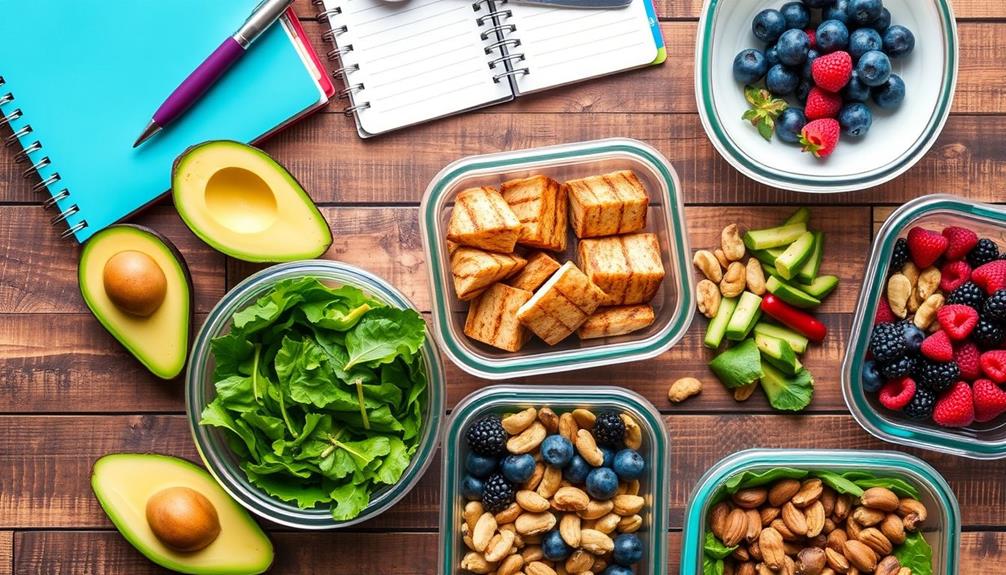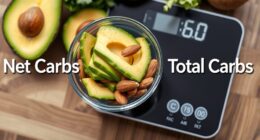To eat a keto diet, you'll cut carbs and increase fats. Aim for 20-50 grams of carbs daily, focusing on high-fat foods like fatty fish, meats, low-carb veggies, and healthy oils. Your meals should consist of about 70% fats, 20% proteins, and 10% carbs. Plan ahead to avoid temptations, and use shopping lists to stick to keto-friendly options. Stay hydrated and be mindful of potential "keto flu" symptoms as your body adapts. With the right strategies, you can thrive on this diet and enjoy its benefits. There's plenty more to explore about making keto work for you!
Key Takeaways
- Limit carbohydrate intake to 20-50 grams daily to encourage ketosis and fat burning.
- Focus on high-fat foods like fatty fish, meats, low-carb vegetables, and healthy oils.
- Plan meals in advance and create shopping lists to avoid unhealthy choices.
- Stay hydrated and monitor electrolytes to manage initial side effects like "keto flu."
- Track macronutrient intake for flexibility and long-term sustainability of the diet.
Understanding the Keto Diet

Understanding the keto diet can feel overwhelming at first, but it's fundamentally about shifting your body's fuel source. This low-carb, high-fat approach drastically reduces your intake of carbohydrates, typically limiting it to just 20-50 grams per day. By doing this, you encourage your body to enter ketosis, a metabolic state where fat becomes your primary energy source instead of carbohydrates.
As a result, your liver produces ketones, which serve as an alternative energy source for your brain. Incorporating nutrient-rich foods like beetroot can provide essential vitamins while keeping your carb intake in check. The ketogenic diet generally consists of a macronutrient ratio of about 70% fat, 20% protein, and only 10% carbohydrates.
You'll want to focus on high-fat foods to eat, such as meat, dairy products, and healthy oils, while avoiding grains, sugary products, and most fruits. Initially, as your body adapts, you might experience some side effects, often referred to as "keto flu," which can include fatigue and irritability. These symptoms usually resolve within a few weeks.
Despite the adjustment period, many people find significant health benefits, including weight loss and improved mental clarity. Embracing the keto lifestyle can lead to a rewarding transformation, both physically and mentally.
Key Food Choices

When you're following a keto diet, your food choices are essential for success. Focus on high-fat foods like fatty fish, meats, and low-carb veggies to keep your carb intake low.
Incorporating mindfulness practices can also help in making better food choices and reducing emotional eating.
At the same time, steer clear of grains and most fruits to maintain ketosis and energy levels.
Essential Foods to Include
To successfully follow a keto diet, you'll want to consistently include essential foods that align with your low-carb goals. Focus on high-fat foods like fatty fish, such as salmon, red meat, and poultry. These options provide lean proteins and healthy fats while keeping your carb intake low.
Additionally, consider brewing methods that enhance your coffee experience, as they can complement your keto lifestyle by providing a low-calorie beverage option that fits your dietary needs, such as different brewing methods for coffee.
Incorporate low-carb vegetables like spinach, broccoli, and zucchini, which are packed with vitamins and minerals and contain less than 8 grams of net carbs per cup.
Dairy products, such as cheese and plain Greek yogurt, can also be included in moderation, as they're low in carbs and high in fat, promoting satiety.
Utilize healthy fats and oils, particularly olive oil and avocados, to add monounsaturated fats that support heart health and help maintain energy levels.
For snacks, consider nuts and seeds, including almonds and chia seeds. They're low in carbs, high in fiber, and rich in nutrients, making them perfect for your ketogenic diet.
Foods to Avoid
A successful keto diet hinges on avoiding certain food choices that can derail your progress. Start by steering clear of high-carb foods, particularly grains like bread, pasta, rice, and cereals. These can easily push you over the recommended daily carb intake of 20-50 grams, vital for maintaining ketosis. Next, it’s important to avoid sugary treats and beverages, as they can also spike blood sugar levels and knock you out of ketosis. Additionally, be wary of starchy vegetables like potatoes and high-sugar fruits such as bananas and grapes. By avoiding these high-carb foods, you can maximize the keto diet benefits such as improved weight management, increased energy, and enhanced mental clarity.
Additionally, understanding your credit score is important for financial health, just as avoiding high-carb foods is essential for a keto diet.
You should also limit starchy vegetables such as potatoes, corn, and sweet potatoes. These can undermine your body's ability to achieve ketosis due to their high carbohydrate content.
Sugary foods are a definite no-go; candies, sodas, fruit juices, and desserts can spike your insulin levels and disrupt your ketogenic diet efforts.
Most fruits, especially high-sugar ones like bananas, grapes, and mangoes, are best avoided. If you crave fruit, opt for low-carb options like berries but only in moderation.
Additionally, processed foods, including chips, crackers, and baked goods, often contain hidden sugars and refined carbohydrates, making them unsuitable for your diet.
Meal Planning Strategies

When it comes to meal planning on a keto diet, effective grocery shopping is key.
You'll want to stock up on high-fat, low-carb ingredients that fit your dietary needs, making weekly meal prep a breeze.
Consider incorporating foods like avocados and nuts, which are beneficial in a gout-friendly diet.
Grocery Shopping Tips
Grocery shopping for a keto diet becomes much easier with a solid meal plan in hand. Start by creating a weekly meal plan that features a variety of high-fat, low-carb foods. Incorporate high-quality meats, dairy, and non-starchy vegetables to guarantee balanced nutrition and prevent last-minute unhealthy choices.
Additionally, understanding the financial considerations for elderly care can help you allocate your grocery budget effectively.
Use shopping lists based on your meal plan to stay focused and stick to keto-friendly items. Prioritize whole foods like avocados, eggs, and leafy greens. Familiarize yourself with food labels, paying close attention to the net carb content. This means subtracting fiber from total carbs to guarantee your purchases align with your daily carb limits, typically 20-50 grams.
Consider bulk purchasing for staples such as nuts, seeds, and healthy oils, which can save you money and keep your pantry stocked with keto-friendly essentials.
Don't forget to explore local farmers' markets or butcher shops to find fresh, high-quality meats and produce. Supporting local businesses not only enhances the flavor and quality of your keto meals but also adds variety to your diet.
Happy shopping!
Weekly Meal Prep
After you've nailed down your grocery shopping with a solid list, it's time to focus on meal prep strategies that will keep you on track with your keto diet. Planning your weekly meals around high-fat, low-carb foods is essential. Include a variety of proteins like meat, poultry, and seafood alongside non-starchy vegetables for nutritional balance.
Batch-cook meals and snacks in advance. Preparing multiple servings of cauliflower rice or zucchini noodles saves time and helps you avoid high-carb temptations. Use meal prep containers to portion out your meals, which assists in tracking your carb intake effectively.
Incorporate healthy fats into every meal, aiming for around 70% of your daily caloric intake from fats. This can include avocados, nuts, seeds, and oils. A meal planning app or simple spreadsheet can streamline tracking your meals and snacks.
Here's a quick reference table for your meal prep:
| Meal Components | Ideas |
|---|---|
| Proteins | Chicken, beef, seafood |
| Non-Starchy Veggies | Spinach, broccoli, zucchini |
| Healthy Fats | Olive oil, avocado, nuts |
| Snacks | Cheese sticks, nut butter |
| Meal Prep Containers | Glass containers, portioned bags |
Health Benefits

The ketogenic diet offers a range of health benefits that extend beyond just weight loss. Research shows that the keto diet may help you shed pounds effectively, with participants losing an average of 2 pounds more than those on low-fat diets.
One of the significant benefits of the keto is its impact on insulin sensitivity, particularly for those with Type 2 diabetes. It can improve blood sugar levels and lower A1C levels, promoting better management of the condition. Additionally, the ketogenic diet can serve as a form of diversification in a health regimen, much like the way investment in precious metals can protect against economic downturns.
Moreover, the high-fat, low-carb nature of the diet supports ketone production, which fuels your brain, potentially boosting mental clarity and cognitive function. This shift in energy sources means you might experience enhanced focus throughout the day.
Additionally, the therapeutic applications of the keto diet are significant; it's been shown to reduce seizure frequency in children with epilepsy who haven't responded well to traditional treatments. There's even some evidence suggesting potential benefits in slowing tumor growth for certain cancer patients.
Embracing the benefits of the keto can lead to a healthier lifestyle and improved well-being in various aspects of your life.
Managing Side Effects

While the ketogenic diet brings numerous benefits, it's important to be aware of potential side effects during the initial adjustment period. Many people experience what's commonly known as the "keto flu," which includes symptoms like fatigue, headaches, and irritability. These side effects usually resolve within a few days to a week.
Additionally, just as understanding toilet maintenance and repairs can improve the longevity of a plumbing system, being proactive about your health can help mitigate keto flu symptoms.
To manage these symptoms effectively, make sure you stay well-hydrated. Increasing your salt intake can also help alleviate headaches and fatigue by maintaining your electrolyte balance.
Since the diet encourages reduced carbohydrate intake, consider gradually lowering your carb levels instead of making a sudden switch. This approach can ease your shift into ketosis and minimize discomfort.
Pay special attention to your electrolytes, particularly magnesium, potassium, and sodium. The ketogenic diet can increase the excretion of these minerals, leading to potential cramps or fatigue.
Long-term Sustainability

Eating a ketogenic diet can be a rewarding journey, but maintaining it long-term can pose challenges for many. The restrictive nature of the diet often makes it tough to stick with, leading to a decline in adherence over time. Studies show that individuals may revert to previous eating habits or regain weight after about six months.
To enhance long-term sustainability, focus on incorporating a variety of high-fat, low-carb foods. Including non-starchy vegetables, nuts, and healthy fats helps prevent nutrient deficiencies, which is vital for overall well-being, much like the key domains of development that influence an individual's growth and health.
Regularly tracking your macronutrient intake is essential; it allows you to stay within your carbohydrate limits while also providing flexibility for occasional treats. This balance can make the diet more enjoyable and manageable.
Additionally, consulting with healthcare professionals or registered dietitians can be invaluable. They can offer personalized strategies tailored to your needs and help you overcome potential health concerns, ensuring you maintain a healthy approach to keto.
Incorporating these practices can considerably improve your chances of sustaining the ketogenic lifestyle, allowing you to enjoy its benefits without compromising your health or happiness.
Common Misconceptions

Many misconceptions surround the ketogenic diet, making it difficult for newcomers to navigate its principles and benefits. One common myth is that the keto diet eliminates all carbohydrates. In reality, you can enjoy low-carb vegetables and a limited amount of low-sugar fruits, like berries, which provide essential nutrients.
Understanding the emotional impact of dietary choices is vital, as individuals with certain mental health conditions may experience different effects from dietary changes.
Another misconception is that consuming high amounts of fat leads to weight gain. The ketogenic diet encourages your body to burn fat for fuel, often resulting in weight loss instead. Some people also believe they can't eat any fruits, but incorporating low-carb options in moderation can be beneficial.
Additionally, many think the keto diet is solely for weight loss; however, it may also help manage various health conditions, including epilepsy and diabetes.
Finally, there's a widespread belief that a high-fat diet is detrimental to heart health. Studies show that the ketogenic diet can improve HDL cholesterol levels and reduce triglycerides in some individuals, countering this myth.
Tips for Success

To succeed on a ketogenic diet, planning your meals in advance is vital. This helps you avoid temptations by ensuring you have a variety of keto-friendly foods ready for quick meals. Familiarize yourself with food labels to accurately track your carbohydrate intake, aiming for a daily limit of 20-50 grams to maintain ideal ketosis.
Incorporate a wide range of low-carb vegetables like spinach, kale, and cauliflower into your meals. These provide essential nutrients while keeping your carb counts low.
Healthy fats should be your primary energy sources; use olive oil, avocado, and coconut oil to make up about 70% of your daily caloric intake.
Don't forget about hydration. Staying well-hydrated is vital, and during the initial adaptation phase, consider increasing your salt intake to help alleviate symptoms of the "keto flu," such as fatigue and headaches.
Frequently Asked Questions
What Are the Basic Rules of a Keto Diet?
To follow the basic rules of a keto diet, you'll drastically reduce carbs to 20-50 grams daily, focus on high-quality fats, and maintain a macronutrient ratio of about 70-75% fats, 20-25% protein, and 5-10% carbs.
How Do I Start Going on Keto?
You might worry about giving up your favorite foods, but starting keto's about embracing new flavors. Calculate your macros, eliminate carbs gradually, and focus on whole foods. Meal prep helps you stay on track effortlessly.
What Foods Are Not Allowed on Keto?
You'll want to avoid foods high in carbohydrates, like bread, rice, pasta, starchy vegetables, most fruits, sugary snacks, and processed items. These can hinder your progress and keep you from reaching ketosis effectively.
How Should I Eat on Keto?
You should focus on high-fat foods like avocados and nuts, keep your carbs low, and choose quality proteins. Incorporate low-carb veggies for nutrients, stay hydrated, and consider electrolytes to maintain balance.
Conclusion
Incorporating the keto diet into your life can feel like maneuvering through a maze, but with the right tools, you can find your way. Just like a skilled gardener prunes their plants for better growth, you'll learn to refine your food choices and meal plans. Remember, it's not just about cutting carbs; it's about nurturing your body with healthy fats. Embrace the journey, stay committed, and you'll cultivate lasting health and well-being.









